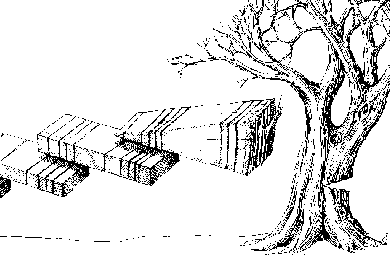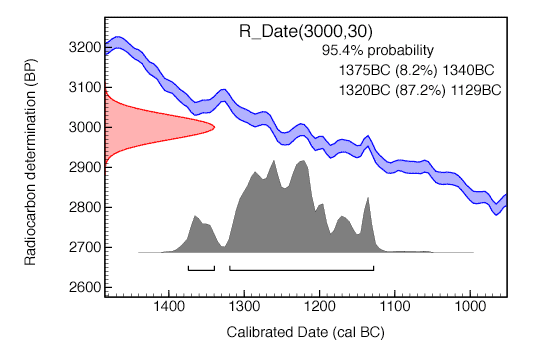
Radiocarbon measurements are always reported in terms of years `before present' (BP). This figure is directly based on the proportion of radiocarbon found in the sample. It is calculated on the assumption that the atmospheric radiocarbon concentration has always been the same as it was in 1950 and that the half-life of radiocarbon is 5568 years. For this purpose `present' refers to 1950 so you do not have to know the year in which the measurement was made.

To give an example if a sample is found to have a radiocarbon concentration exactly half of that for material which was modern in 1950 the radiocarbon measurement would be reported as 5568 BP.
For two important reasons, this does not mean that the sample comes from 3619 BC:
In order to see what a radiocarbon determination means in terms of a true age we need to know how the atmospheric concentration has changed with time.

Many types of tree reliably lay down one tree ring every year. The wood in these rings once laid down remains unchanged during the life of the tree. This is very useful as a record of the radiocarbon concentration in the past. If we have a tree that is 500 years old we can measure the radiocarbon in the 500 rings and see what radiocarbon concentration corresponds to each calendar year.
Using very old trees (such as the Bristlecone Pines in the western U.S.A.), it is possible to make measurements back to a few thousand years ago.
To extend this method further we must use the fact that tree ring widths vary from year to year with changing weather patterns. By using these widths, it is possible to compare the tree rings in a dead tree to those in a tree that is still growing in the same region. By using dead trees of different but overlapping ages, you can build up a library of tree rings of different calendar ages. This has now been done for Bristlecone Pines in the U.S.A and waterlogged Oaks in Ireland and Germany, and Kauri in New Zealand to provide records extending back over the last 14,000 years.
For older periods we are able to use other records of with idependent age control to tell us about how radiocarbon changed in the past.
The information from measurements on tree rings and other samples of known age (including speleothems, marine corals and samples from sedimentary records with independent dating) are all compiled into calibration curves by the IntCal group. These are the basis for the calibrations performed by the programs like CALIB and OxCal.
For more detail see the OxCal manual.
Calibration of radiocarbon determinations is in principle very simple. If you have a radiocarbon measurement on a sample, you can try to find a tree ring with the same proportion of radiocarbon. Since the calendar age of the tree rings is known, this then tells you the age of your sample.
In practice this is complicated by two factors:
These effects are most clearly seen by looking at a specific example.

This plot shows how the radiocarbon measurement 3000+-30BP would be calibrated. The left-hand axis shows radiocarbon concentration expressed in years `before present' and the bottom axis shows calendar years (derived from the tree ring data). The pair of blue curves show the radiocarbon measurements on the tree rings (plus and minus one standard deviation) and the red curve on the left indicates the radiocarbon concentration in the sample. The grey histogram shows possible ages for the sample (the higher the histogram the more likely that age is).
The results of calibration are often given as an age range. In this case, we might say that we could be 95% sure that the sample comes from between 1375 cal BC and 1129 cal BC.
See also ORAU's Explanation of Radiocarbon Results.
This is not intended to be an exhaustive summary of radiocarbon calibration conventions but a brief guide.
Radiocarbon dates should always be reported either as `percent modern' or years `before present' (BP). The first indicates the proportion of radiocarbon atoms in the sample as compared to samples modern in 1950. The second is directly derived from this on the assumption that the half-life of radiocarbon is 5568 years and the amount of radiocarbon in the atmosphere has been constant.
Once calibrated a radiocarbon date should be expressed in terms of cal BC, cal AD or cal BP. The cal prefix indicates that the dates are the result of radiocarbon calibration using tree ring data. These values should correspond exactly to normal historical years BC and AD. The term cal BP means the number of years before 1950 and can be directly compared to calendar years.
There are two main methods used for calculating age ranges from the calibration curve:
The first method to be employed was called the `intercept method' because it can be done by drawing intercepts on a graph. This method will tell you the years in which the radiocarbon concentration of tree rings is within two standard deviations of your measurement (e.g. between 2940BP and 3060BP for the measurement 3000+-30BP).
A slightly different method is now more often used which is called the `probability method'. This requires a computer since the calculations are more complicated. It gives the time range, from which you can be 95% sure the sample came.
There are a number of calibration programs available including the windows program OxCal and CALIB, which runs on several platforms including an online version (server at Belfast).